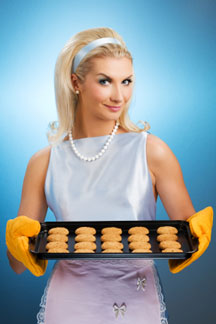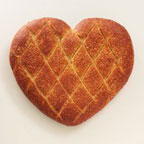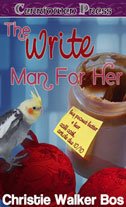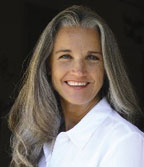Baking a Romance…A Recipe for Success Part 1 of 2
 By Christie Walker Bos
By Christie Walker BosSome people think all romance novels follow a secret recipe or formula and are therefore all the same. Crafting the modern romance is like baking a loaf of bread. While there are the standard ingredients that will give you a presentable finished loaf, it's what's added to the basics that can make enough types of breads to fill a bakery.
For basic white bread you need flour, yeast, butter, salt and water. For the basic romance novel you need two people who eventually fall in love, a plot/conflict that keeps them apart for most of the novel, and then a resolution that brings them together for the happy ending. Just like with baking, if you want your story to be more than just "white bread" you'll need to add to the basic ingredients to stand out on the shelf.
Type of Bread…Determining the Genre
 When you set out to bake a loaf of bread, you first need to determine what type of bread you're making in order to assemble all the necessary ingredients. With a romance novel, your first order of business will be to decide what type of romance you want to write. Romance novels come in as many varieties as bread. There's the murder mystery romance in which there will be dead bodies and the paranormal romance in which the lovers are not necessarily even alive. There are historical, contemporary and science fiction romances, suspense, fantasy and inspirational love stories. Books that cross over and back again from one genre to another are making it more difficult to pigeon hole a romance novel with a specific, limiting set of ingredients.
When you set out to bake a loaf of bread, you first need to determine what type of bread you're making in order to assemble all the necessary ingredients. With a romance novel, your first order of business will be to decide what type of romance you want to write. Romance novels come in as many varieties as bread. There's the murder mystery romance in which there will be dead bodies and the paranormal romance in which the lovers are not necessarily even alive. There are historical, contemporary and science fiction romances, suspense, fantasy and inspirational love stories. Books that cross over and back again from one genre to another are making it more difficult to pigeon hole a romance novel with a specific, limiting set of ingredients.The Basic Ingredients…Characters are the Flour and Water of Romance
In traditional romances, boy meets girl, they fall in love and they live happily ever after. Today, you might have boy meets vampire, girl meets werewolf, boy meets boy or girl meets girl. The possibilities are as boundless as your imagination. Today's romances could involve a ghost in love with a living person (Think Patrick Swayze in Ghost) or a time traveler in love with someone from the past (Think Christopher Reeve in Somewhere in Time). Add spice to the recipe by creating characters from different ethic backgrounds, different classes, different centuries, and different worlds. These differences will cause issues to arise between the characters, which brings us to our next ingredient…yeast!
Don't Forget the Yeast…Getting a Rise Out of Your Characters
 When making bread, yeast is the active ingredient that makes the bread rise. When writing a story, conflict is the active ingredient that gives rise to problems that demand a solution. Without conflict, two people meet, fall in love and live happily ever after…The End. Boring. The conflict or the reason they can’t be together is what makes "the bread rise" and the story develops around how they resolve the problems that are keeping them apart.
When making bread, yeast is the active ingredient that makes the bread rise. When writing a story, conflict is the active ingredient that gives rise to problems that demand a solution. Without conflict, two people meet, fall in love and live happily ever after…The End. Boring. The conflict or the reason they can’t be together is what makes "the bread rise" and the story develops around how they resolve the problems that are keeping them apart.In my romantic comedy, Getting Back to Delaney, there are two types of conflict, internal and external. Delaney, the owner of a struggling art gallery finds herself attracted to Tyler, who turns out to be helping his brother open a competing art gallery across the street. A classic conflict arises as Delaney views Tyler as the competition out to destroy her. Think You’ve Got Mail with Tom Hanks and Meg Ryan. Delaney's internal conflict--a deep distrust of anything in a "male package" brought on by repeated betrayals--causes her to ignore Tyler's offers of help even though she desperately needs it, causing her gallery to teeter on the brink of bankruptcy.
Add Spices…Create Flavor with Your Setting
 Think of the setting of your book as more than the actual location where events take place. The setting has a personality, it provides conflict, and it adds flavor to your book like cinnamon changes white bread into a cinnamon roll. In my novel, The Write Man for Her, the story takes place in and around Santa Monica and Marina Del Rey, California. One of the characters lives on a houseboat at the marina, which provides for sunsets on the water, love scenes in rhythm with the gentle rocking of the boat, and sets the stage for the books grand finale.
Think of the setting of your book as more than the actual location where events take place. The setting has a personality, it provides conflict, and it adds flavor to your book like cinnamon changes white bread into a cinnamon roll. In my novel, The Write Man for Her, the story takes place in and around Santa Monica and Marina Del Rey, California. One of the characters lives on a houseboat at the marina, which provides for sunsets on the water, love scenes in rhythm with the gentle rocking of the boat, and sets the stage for the books grand finale.The love story Slumdog Millionaire set in the slums of India has a desperate, dangerous feeling that permeates the film like the pungent smell of curry. While in The Bridges of Madison County, the pace of the film is slow and quiet like the dust caught in a beam of light coming through the farm house window. Take care when choosing your setting, understanding that the location can enrich the plot, influence the characters and increase or decrease the tension of your story.
~~~~
 In Part Two…Learn how to crank up the heat, let your story cool, and then enjoy the delicious results. (Come back for Part 2 on Friday, March 27th!)
In Part Two…Learn how to crank up the heat, let your story cool, and then enjoy the delicious results. (Come back for Part 2 on Friday, March 27th!)Christie Walker Bos is the editor of a trade journal for the optical industry. In her "spare time" she writes romantic comedy novels. Excerpts, reviews and links to her three published novels can be found on her Web site at https://www.ChristieWalkerBos.com
Labels: baking a romance, Christie Walker Bos, recipe for success, Romance Writing, The Write Man for Her











